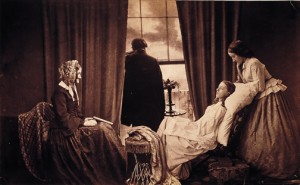 Here’s an excerpt from the third and last part of the interview with me by Dr. Lisa Marcucci at Inside Surgery. The question asked for a little known fact from the history of medicine.
Here’s an excerpt from the third and last part of the interview with me by Dr. Lisa Marcucci at Inside Surgery. The question asked for a little known fact from the history of medicine.
Easing the pain of death was a common medical practice in the 19th century. The doctor’s black bag contained laudanum as early as the 1600s. The 19th century added morphine (1806), codeine (1836), and aspirin (1892), along with the anesthetics chloroform and ether. At a time when physicians had very little to offer patients by way of cures – other than the ineffective “heroic” measures of bloodletting and purges — it was palliative care that made physicians welcome at the deathbed.
In those days, easing pain at the time of death was not called palliative care, but euthanasia. The term referred to the outward death of the body, in contrast to the death of the spirit. Euthanasia literally means a good death.
In 1870 a school teacher named Samuel Williams published an essay that used the term euthanasia to mean something else: mercy killing. The essay generated considerable interest and discussion. To make a long story short, the original meaning of the term euthanasia was completely lost.
Between those late 19th century discussions of euthanasia as mercy killing and 1975, when Balfour Mount introduced the term palliative care, there was no name for supportive care of the dying. Without a name, there could be no specialists in the subject, no professors to teach it, no training for physicians. There was little discussion of the subject in medical schools. Without a name, the subject could not be indexed and researched in medical literature. There could be no advances in knowledge or improvement in techniques.
The power of language
What we now call palliative care had greatly enhanced the reputation of the medical profession in the late 19th century. How could the original meaning of “euthanasia” be so easily displaced?
In an essay on the subject, Ezekiel Emanuel suggests that it happened at a particular moment in the development of capitalism — a time of economic panics and stock market crashes, raw individualism, economic competition, and appeals to the Darwinian concept of survival of the fittest. Euthanasia of the elderly, who were no longer productive members of society, was simply part of the universal struggle of the strong over the weak.
This incident illustrates the power of language. If you control the vocabulary – so important today in discussions of morally tinged political issues (death panels, right to life) — you can prevail.
Related links:
Atul Gawande: Modern death and dying
Olbermann on the damage done by “death panels”
Daily Dose: Palliative sedation
Were “death panels” a teachable moment for palliative care?
Death be not visible
Resources:
Image source: The Royal Holloway Victorian MA Blog
Robert B. Baker and Laurence B. McCullough, Medical Ethics through the Life Cycle in Europe and the Americas, The Cambridge World History of Medical Ethics, 2008
Ezekiel J. Emanuel, The History of Euthanasia Debates in the United State and Britain, Annals of Internal Medicine, November 15, 1994, Vol. 121 no. 10 pp 793-802.


Sorry, comments are closed for this post.